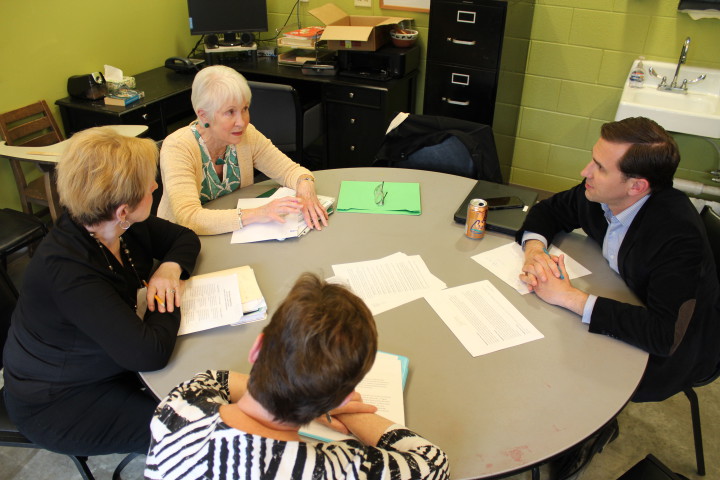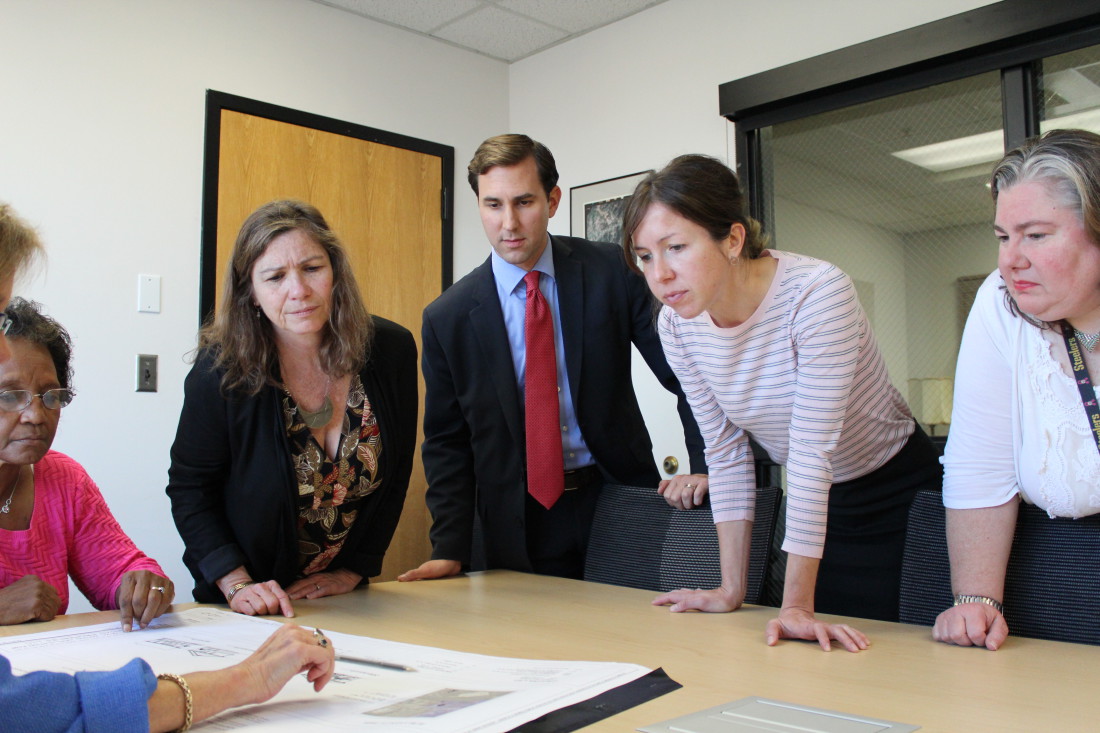“Years must pass before every objective named in the Plan can possibly be realized. It will be the work of a generation. For that reason no set of definite recommendations can be any more than a flexible outline — subject to the expressed will of the people.”
— foreword to John Nolen’s 1922 Asheville City Plan
Asheville may fairly be called a city of many plans, yet the comprehensive plan update approved by City Council on April 26 will in fact be only the fourth planning effort to address the city as a whole.
The first such plan, authored by pioneering urban visionary John Nolen in 1922 and adopted two years later, outlined broad land-use principles and designated major transportation corridors. Some recommendations, such as a subway between Pack Square and West Asheville, might strike modern readers as far-fetched. Others, such as where to site the city’s incinerator, are decidedly pragmatic. Still others express anachronistic attitudes whose legacies still shape the city today, such as a passage noting the “distinct advantages” of separating neighborhoods for white residents from those for other races.
Asheville continued to grow robustly up until the 1929 stock market crash. The Great Depression inaugurated a long period of stagnation, during which the city’s population grew slowly and a crushing debt burden made new investment impossible. It wasn’t until 1987 that the next big picture effort, the Asheville City Plan 2010, was adopted by a City Council led by then-Mayor W. Louis Bissette. From 1960 through 1980, the document notes, Asheville actually lost population to Buncombe County, thereafter achieving modest population growth through annexation. The 2010 Plan also reflects a new concern for incorporating significant public input.
By the time the city embarked on the next-generation comprehensive planning process in the early 2000s, population growth had picked up steam. In response, planners embraced the concept of “smart growth” as a guiding framework for the Asheville City Development Plan 2025, which was adopted in 2003 under Mayor Charles Worley. The 2025 Plan encourages strategies such as mixed-use development, adaptive reuse, multimodal transportation planning and continued downtown revitalization. This plan also expanded the avenues for public engagement: For the first time, residents could submit comments online; the city also provided a dedicated telephone line and a storefront office for the planning effort.
In an April 26 presentation to City Council, Todd Okolichany, the city’s director of planning and urban design, spelled out why he believes it’s time for Asheville to once again embark on a comprehensive planning process. Since 2003, the city’s population has increased by 16,000 to an estimated 89,000. Major new employers have come to town, and revitalization efforts have expanded beyond downtown to encompass the River Arts District, Biltmore Village and Haywood Road. Among the concerns the planning process will consider, he continued, are the shortage of affordable housing, low-wage employment, climate change, multimodal transportation needs and the resiliency of the local economy.
The comprehensive plan will also guide future decisions on things like zoning amendments, infrastructure planning, development review and resource allocation.
Vice Mayor Gwen Wisler, who chairs the city’s Planning and Economic Development Committee, says the comprehensive effort is the most important project the city will undertake this year. An extensive series of public meetings and online surveys over the 15- to 18-month process will offer numerous opportunities for city residents to give input, and Wisler says she’s eager to see what they believe are the most important issues. For her part, the vice mayor expects city neighborhoods and a new focus on the concept of equity to be key topics.
Neighborhoods weigh in
Months before a consultant was chosen, city staff had begun working to engage neighborhoods in the planning process. On Nov. 7, Okolichany led a workshop attended by 33 neighborhood representatives. He outlined the city’s “Plan on a Page” format, which can help groups organize and build consensus around local priorities that will inform policy decisions affecting the city as a whole.

On April 19, city staff led a work session for neighborhood representatives. Neighborhood Coordinator Marsha Stickford says representatives of 20 different residential areas took advantage of the opportunity to hash out the details of their plans with planning staff. Rachel Jensen, president of West Asheville’s Wilshire Park neighborhood association, praised the city’s efforts, saying, “In our neighborhood, this process is bringing people together.”
Martha McKinney of the Sweeten Creek Association of Neighborhoods agreed. “Never before have neighborhoods been this involved in the comprehensive plan,” she said. Renee White, who heads the East End/Valley Street Neighborhood group, said she was glad for the chance to share her fellow residents’ concerns, particularly the increasing volume of cut-through traffic on Martin Luther King Jr. Drive. She also intends to request new signage to reinforce the neighborhood’s identity.
The city, says Stickford, hopes to receive all the individual plans by July 1. So far, she’s pleased with the response, saying, “People are taking it seriously and being very thoughtful in creating their plans.”
A more equitable vision
The term “equity” entered the city’s vocabulary in a big way in January, when the newly elected City Council adopted a strategic, 20-year vision for Asheville. By 2036, Council declared, the city will be able to say that “cultural diversity and social and economic equity are evident in all that we do.”
But what does equity mean in the context of local government?
According to Council member Gordon Smith, who pushed for a new focus on the principle during City Council’s annual planning retreat, equity means promoting full equality for all. Historically, he explains, society has undertaken land-use projects that have broken up established black and ethnic neighborhoods. These disruptions made it difficult for minority business owners and neighborhood residents to thrive, both economically and socially. Other inequalities, including a lack of access to education and capital, have also contributed to the wide gap in wealth between minority and white populations. Equity also requires acknowledging those historical injustices and other factors as it seeks to provide equal opportunity today.
Wisler, meanwhile, says equity can help frame our thinking on a wide range of issues, from LGBT rights to the plight of independent business owners struggling to afford rising rents in Asheville’s increasingly popular downtown. At the same time, she notes, local government often finds itself constrained in its ability to implement programs aimed at expanding social and economic equity. Despite those limitations, Wisler hopes the planning process will give City Council new insights into “what the public would like us to do, if we could.”
Assembling the A-team
Staffer Stacy Merten, the Planning Department’s lead contact on the project, says Asheville’s request for proposals netted responses from nine consultants. After interviewing four finalists, the city awarded the $264,000 contract to a team headed by Skidmore, Owings & Merrill, an architecture and planning firm with offices around the world.
Project manager Jennifer Pehr stresses the importance of the team’s partner organizations, each of which contributes a different skill set. The Asheville-based Design Workshop has expertise in landscape planning and the public realm; another local firm, Chipley Consulting, will play a key role in facilitating public engagement. The St. Louis-based Development Strategies Inc. has extensive economic development and land use planning experience. And national transportation planners VHB Engineering’s Charlotte office will conduct transportation, public infrastructure and resiliency studies.
Although SOM completes hundreds of plans around the world every year, “We won’t be opening our briefcase and pulling out trends that are hot elsewhere,” stresses SOM principal Kristopher Takacs. “This needs to be about what is authentically, uniquely Asheville. And that starts with a process of listening and discovery.”
Extensive public input will be an important component of the project. In coordination with city planning staff, the consultant team will conduct public meetings and town hall discussions, says Pehr. Open City Hall, the city’s new online platform, will be another channel for gathering feedback. “We’re really trying to address and reach a very representative group of the population,” she explains, “and not only those who regularly participate in the public process.”
Wisler concurs. “By using some of the technology, I’m hoping we can capture the input of people who don’t usually show up at these meetings,” she says, adding, “We’re getting better and better at it.”
At its May 10 meeting, City Council agreed to appoint an advisory group of 15 Asheville residents to guide the planning process. It will include a representative from each of the city’s 12 boards and commissions, plus three at-large members. Applications for the latter slots will be accepted through Wednesday, June 8. Residents, says Wisler, may also participate in focus groups targeting specific subjects such as transportation, affordable housing and the environment.
Reinventing the wheel?
Wisler reminds those who see broad-scale planning processes like this one as “pie in the sky” and “a little wonky” that Asheville won’t be starting from scratch. “We already have a comprehensive plan, so we won’t be learning how to do this for the first time,” she points out. Asheville has created many thoughtful and detailed plans in recent years, continues Wisler, and she wants to see all of them reflected in the next-generation plan.
Six principles widely recognized by planning organizations as best practices for sustainability will be used as a framework for Asheville’s process, Merten explains. They are:
1) Connect land-use planning with multimodal transportation planning.
2) Mitigate impacts of climate change.
3) Maintain a resilient and diversified economy.
4) Promote community and housing equity.
5) Encourage healthy communities.
6) Enhance local and regional partnerships.
And while she agrees that many of the same issues that claimed center stage in the 2025 Plan will also drive the 2035 edition, Merten predicts that the new plan will include “different ways to deal with ongoing issues.” For example, she continues, “In the future, it will be increasingly important for the city to partner with private entities to accomplish things.” In that vein, notes Merten, the consultants will also be working to integrate the findings of the forthcoming Climate Adaptation Report, which UNC Asheville’s National Environmental Modeling and Analysis Center is currently working on.
The big picture
The comprehensive plan, Okolichany told City Council, will help “ensure that Asheville continues to be forward-thinking and … a diverse, livable, clean and healthy community.”
Takacs, meanwhile, says, “Asheville is an extraordinary place: That’s what drew us to it. … This process is about the city writing its own future. Our job as consultants is to lead, guide and listen, and offer steps to get there.”
Pehr says she’s looking forward to helping Asheville articulate its distinctive personality. “You know you’re in Asheville when you are in Asheville,” she points out. “There’s a clear sense of place and community. Asheville is at a really unique point to be a leader among this size of city in America.” The comprehensive plan, she concludes, “will provide a road map for where you want to go — and how you plan to get there.”






Before you comment
The comments section is here to provide a platform for civil dialogue on the issues we face together as a local community. Xpress is committed to offering this platform for all voices, but when the tone of the discussion gets nasty or strays off topic, we believe many people choose not to participate. Xpress editors are determined to moderate comments to ensure a constructive interchange is maintained. All comments judged not to be in keeping with the spirit of civil discourse will be removed and repeat violators will be banned. See here for our terms of service. Thank you for being part of this effort to promote respectful discussion.